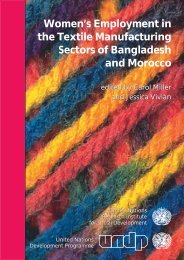The Politics of Gender and Reconstruction in Afghanistan
The Politics of Gender and Reconstruction in Afghanistan
The Politics of Gender and Reconstruction in Afghanistan
You also want an ePaper? Increase the reach of your titles
YUMPU automatically turns print PDFs into web optimized ePapers that Google loves.
THE LEGACIES OF CONFLICT: IS THERE A GENDER SUB-TEXT?<br />
(<strong>and</strong> children’s) vulnerabilities. 18 Rub<strong>in</strong> (2004), for <strong>in</strong>stance, draws attention to the fact that warlords <strong>and</strong> drug<br />
traffickers who keep cultivators <strong>in</strong> debt bondage stimulate the resort to “giv<strong>in</strong>g” their daughters to traffickers as<br />
wives. <strong>The</strong> loss <strong>of</strong> personal <strong>and</strong> community autonomy <strong>in</strong> the context <strong>of</strong> the “comm<strong>and</strong>er system” that enmeshes<br />
clients <strong>in</strong> bonds <strong>of</strong> <strong>in</strong>debtedness <strong>and</strong> dependence also <strong>in</strong>creases vulnerability to abuses <strong>of</strong> various k<strong>in</strong>ds. In<br />
some contexts, heavy veil<strong>in</strong>g by women may itself be a defensive response to predatory parties exercis<strong>in</strong>g droit<br />
de seigneur rather than an expression <strong>of</strong> religion or culture (Wood 2003). Indeed, <strong>in</strong>terpret<strong>in</strong>g these patterns as<br />
some unmediated expression <strong>of</strong> local culture only acts to conceal the complex nexus <strong>of</strong> <strong>in</strong>fluences that deepen<br />
the vulnerability <strong>of</strong> women <strong>and</strong> girls.<br />
Despite the serious pressures women were subjected to, there is some evidence that women’s solidarity networks<br />
<strong>and</strong> organizations, some <strong>of</strong> which operated cl<strong>and</strong>est<strong>in</strong>ely under the Taliban, acted as a medium <strong>of</strong> both political<br />
resistance <strong>and</strong> empowerment (Povey 2003). Organizations such as the Union <strong>of</strong> Afghan Women, the Women’s<br />
Vocational <strong>and</strong> Tra<strong>in</strong><strong>in</strong>g Centre <strong>and</strong> the Women’s Association <strong>of</strong> <strong>Afghanistan</strong>, to name but a few, mobilized pr<strong>of</strong>essional<br />
women who <strong>of</strong>fered their services as doctors or teachers, <strong>of</strong>fer<strong>in</strong>g literacy classes <strong>and</strong> skills tra<strong>in</strong><strong>in</strong>g to<br />
numerous girls <strong>and</strong> boys <strong>in</strong> homes turned <strong>in</strong>to cl<strong>and</strong>est<strong>in</strong>e schools. Indeed, Johnson <strong>and</strong> Leslie (2002) po<strong>in</strong>t<br />
out that the war years stimulated the dem<strong>and</strong> for girls’ education, partly due to exposure to school<strong>in</strong>g <strong>in</strong> refugee<br />
camps. Some UN agencies <strong>and</strong> NGOs endeavoured to safeguard humanitarian assistance projects target<strong>in</strong>g<br />
women <strong>and</strong> attempted to keep their female staff <strong>in</strong> employment. <strong>The</strong>re was <strong>of</strong>ten a tension, however, between<br />
commitment to women’s rights <strong>and</strong> the delivery <strong>of</strong> humanitarian assistance. 19 Some successful programmes were,<br />
nonetheless, able to operate. For <strong>in</strong>stance, bakeries staffed by women were set up by the World Food Programme<br />
(WFP) to assist widows <strong>and</strong> the poorest women by provid<strong>in</strong>g them with subsidized bread. <strong>The</strong> UN Habitat Community<br />
Fora, which were created through the “Rebuild<strong>in</strong>g Communities <strong>in</strong> Urban <strong>Afghanistan</strong>” project to promote<br />
community <strong>in</strong>itiatives, set up women’s community fora (WCFs) to provide opportunities for <strong>in</strong>come generation<br />
<strong>and</strong> to support women’s community leadership roles. <strong>The</strong> WCFs operated <strong>in</strong> difficult conditions under the<br />
Taliban, <strong>in</strong>clud<strong>in</strong>g permanent surveillance <strong>and</strong> a degree <strong>of</strong> cl<strong>and</strong>est<strong>in</strong>ity. However, the fact that there were no<br />
other avenues for women’s pr<strong>of</strong>essional <strong>and</strong> community activities meant that women with high levels <strong>of</strong> education<br />
<strong>and</strong> skill devoted their energies to the fora, which served as tra<strong>in</strong><strong>in</strong>g grounds for others. Paradoxically, when<br />
the dem<strong>and</strong> for skilled personnel <strong>in</strong>creased after the establishment <strong>of</strong> the <strong>Afghanistan</strong> Transitional Authority<br />
(ATA), the expansion <strong>of</strong> the activities <strong>of</strong> <strong>in</strong>ternational organizations meant that the best talent was diverted<br />
to higher earn<strong>in</strong>g jobs <strong>in</strong> those organizations, dim<strong>in</strong>ish<strong>in</strong>g the spirit <strong>of</strong> voluntarism that animated many women’s<br />
civil society <strong>in</strong>itiatives.<br />
<strong>The</strong> fall <strong>of</strong> the Taliban was the result <strong>of</strong> Operation Endur<strong>in</strong>g Freedom <strong>in</strong> the wake <strong>of</strong> 11 September 2001,<br />
which targeted the regime’s Al Qaeda backers under the banner <strong>of</strong> the fight aga<strong>in</strong>st <strong>in</strong>ternational terrorism. This<br />
operation was carried out by a US-led <strong>in</strong>ternational military coalition complemented by Afghan opposition<br />
factions, many <strong>of</strong> which had been <strong>in</strong>volved <strong>in</strong> the devastat<strong>in</strong>g civil war <strong>of</strong> the early 1990s. <strong>The</strong> <strong>in</strong>ternational<br />
community <strong>and</strong> the United Nations acted rapidly to br<strong>in</strong>g these factions <strong>and</strong> the political leadership <strong>in</strong> the<br />
Afghan diaspora together to agree to <strong>in</strong>terim power-shar<strong>in</strong>g arrangements that led to the Bonn Agreement <strong>of</strong><br />
December 2001.<br />
18 A recent study by the International Organization for Migration (IOM) shows that there is a grow<strong>in</strong>g human traffick<strong>in</strong>g problem <strong>in</strong> <strong>Afghanistan</strong>, with victims<br />
drawn from among the destitute, the displaced <strong>and</strong> the <strong>in</strong>debted. Young rural women (<strong>and</strong> children) are subjected to forced prostitution, forced<br />
labour <strong>and</strong> practices ak<strong>in</strong> to slavery (abduction <strong>and</strong> forced marriage, exchange <strong>of</strong> women to settle disputes, or marriage <strong>in</strong> exchange for debt repayment)<br />
(IOM 2003).<br />
19 Agencies like the World Food Programme (WFP) issued directives that at least half the beneficiaries <strong>of</strong> food-for-work projects had to be women; this<br />
resulted <strong>in</strong> a significant reduction <strong>in</strong> the food aid made available even to women. Some agencies discont<strong>in</strong>ued their programmes altogether. Others<br />
adopted a more accommodat<strong>in</strong>g approach, negotiat<strong>in</strong>g concessions with respect to the employment <strong>of</strong> women (with 5,874 female personnel <strong>in</strong> the<br />
<strong>in</strong>ternational assistance community).<br />
PAGE 11
















